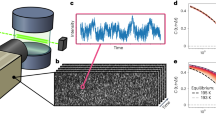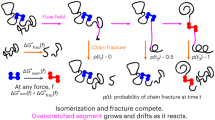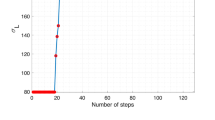Abstract
IN recent years, several non-stationary state methods1–5 have been developed for the measurement of kinetic life-times and hence the velocity coefficients for the propagation and termination steps in polymerization reactions. These methods, with the exception of that of Burnett1, depend upon the system remaining virtually adiabatic for periods of at least 10 sec. following the commencement of irradiation; this is due to the very slow conduction of heat through the walls of the reaction vessels. Burnett's results, which were interpreted on the basis of the system remaining isothermal during the reaction, can alternatively be explained6 if non-isothermal conditions prevail during the reaction. This, however, invalidates the method as a means of measuring non-stationary states. The method reported here, like that of Burnett1, involves the measurement of change of volume immediately following the beginning of irradiation, but differs in that the non-stationary state period is measured from the volume expansion–time curve instead of the contraction–time curve.
This is a preview of subscription content, access via your institution
Access options
Subscribe to this journal
Receive 51 print issues and online access
$199.00 per year
only $3.90 per issue
Buy this article
- Purchase on Springer Link
- Instant access to full article PDF
Prices may be subject to local taxes which are calculated during checkout
Similar content being viewed by others
References
Burnett, G. M., Trans. Faraday Soc., 46, 772 (1950).
Majury, T. G., and Melville, H. W., Proc. Roy. Soc., A, 205, 496 (1951).
Grassie, N., and Melville, H. W., Proc. Roy. Soc., A, 207, 285 (1951).
Bengough, W. I., and Melville, H. W., Proc. Roy. Soc., A, 225, 330 (1954).
Fujii, A., and Tanaka, S., J. Polymer Sci., 20, 409 (1956).
Bengough, W. I., Trans. Faraday Soc. (in the press).
Matheson, M. S., Bevilacqua, H., Auer, A., and Hart, R. H., J. Amer. Chem. Soc., 71, 2610 (1949).
Bartlett, P. D., Broadbent, H. S., and Kwart, H., J. Amer. Chem. Soc., 72, 1060 (1950).
Dixon-Lewis, G., Proc. Roy. Soc., A, 198, 510 (1949).
Author information
Authors and Affiliations
Rights and permissions
About this article
Cite this article
BENGOUGH, W. A Dilatometric Method of following the Non-stationary State of Polymerization Reactions. Nature 180, 1120–1121 (1957). https://doi.org/10.1038/1801120a0
Issue Date:
DOI: https://doi.org/10.1038/1801120a0
Comments
By submitting a comment you agree to abide by our Terms and Community Guidelines. If you find something abusive or that does not comply with our terms or guidelines please flag it as inappropriate.



